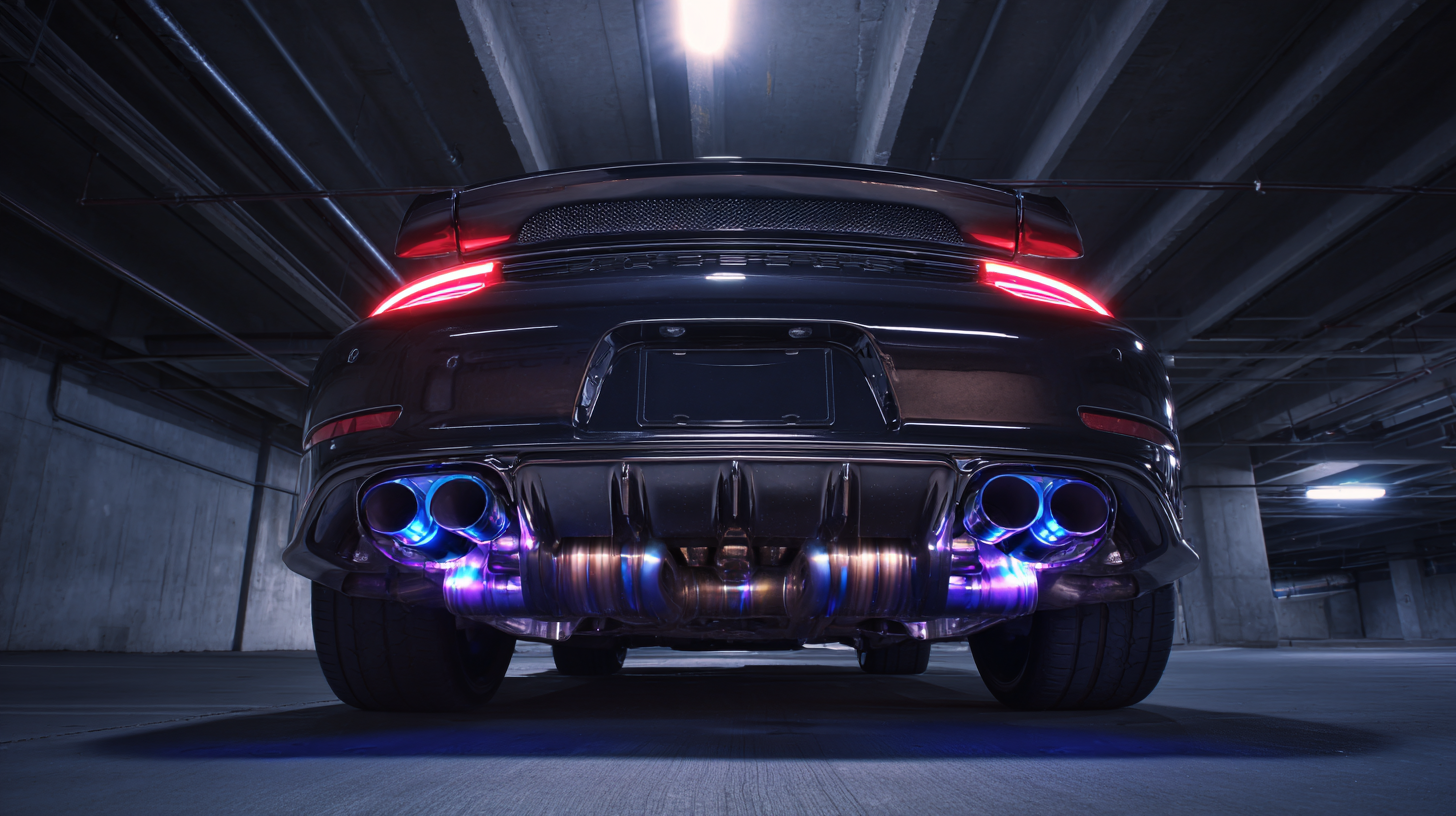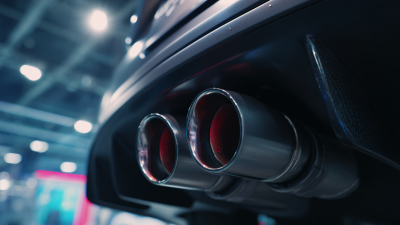7 Essential Tips for Choosing the Perfect Straight Pipe Exhaust System
When it comes to enhancing vehicle performance and sound, selecting the right
Straight Pipe Exhaust System is crucial for automotive enthusiasts.
According to the Specialty Equipment Market Association (SEMA),
the aftermarket automotive exhaust system industry was valued at approximately
$1 billion in 2022, reflecting a growing demand for
high-performance enhancements among vehicle owners. A well-chosen straight pipe exhaust can
improve exhaust flow, reduce back pressure, and significantly alter the sound dynamics of a car,
leading to an exhilarating driving experience. However, with a plethora of options available,
from various materials to differing diameters, choosing the perfect system can be daunting.
This guide will provide you with seven essential tips
to navigate this choice, ensuring that you select a straight pipe exhaust system that not only
maximizes your vehicle's performance but also satisfies your personal style and sound preferences.

Understanding the Basics: What is a Straight Pipe Exhaust System?
A straight pipe exhaust system is a type of exhaust setup designed to improve engine performance by allowing exhaust gases to flow freely. Unlike traditional exhaust systems, it eliminates restrictions such as mufflers and resonators, resulting in a louder and more aggressive sound. This system can enhance horsepower and torque, making it a popular choice among enthusiasts looking to maximize their vehicle's performance. Understanding the fundamentals of a straight pipe system is crucial for choosing the right one for your needs.
When selecting a straight pipe exhaust system, it's essential to consider factors such as pipe diameter, material quality, and compatibility with your vehicle. The diameter affects exhaust flow; larger pipes can improve performance but may require tuning adjustments. Quality materials, such as stainless steel, ensure durability and resistance to rust. Furthermore, a system designed specifically for your vehicle model guarantees proper fitment and performance alignment. By understanding these basics, you can make an informed decision that enhances your vehicle's performance while also fitting your personal style preferences.
Consider Your Vehicle Type: Tailoring the Exhaust to Your Needs
When selecting the perfect straight pipe exhaust system, understanding your vehicle type is crucial. Different vehicles require distinct exhaust systems to optimize performance and adhere to legal regulations. For instance, a Ford Mustang may benefit from a performance-oriented exhaust system that enhances horsepower, while a Honda Civic might need a system that focuses more on sound quality and aesthetic appeal. According to a report by the Specialty Equipment Market Association (SEMA), nearly 30% of consumers prioritize sound quality when upgrading their exhaust, strongly linking specific system designs to various vehicle makes.
Tip 1: Assess your engine’s specifications. Ensure the diameter and material of the exhaust pipes match the vehicle’s horsepower and displacement to avoid backpressure issues that could hinder performance.
Tip 2: Consider local regulations. Many regions have laws governing vehicle noise levels; thus, confirming compliance with these regulations will save you from potential fines and inconvenience.
By carefully tailoring your exhaust system to match your vehicle's specifications and needs, you can significantly enhance the overall driving experience while maximizing the benefits of a straight pipe system.

Material Matters: Choosing the Right Material for Durability and Performance
When selecting a straight pipe exhaust system, the choice of material plays a pivotal role in determining both durability and performance. Stainless steel is often favored due to its excellent corrosion resistance and strength. According to a report by the Specialty Equipment Market Association (SEMA), stainless steel exhaust systems can last up to three times longer than those made from mild steel, especially in harsh conditions. This longevity not only translates to fewer replacements but also enhances the vehicle's overall performance by maintaining optimal exhaust flow over time.
Another material option is aluminized steel, which offers cost-effective benefits while still providing decent protection against rust. However, it may have a significantly shorter lifespan, especially when exposed to moisture and road salts. A study published in the Journal of Automotive Engineering suggests that vehicles equipped with aluminized exhaust systems can lose up to 30% of their effectiveness within five years due to corrosion. Therefore, understanding the specific driving conditions and environmental factors is crucial in making an informed decision about the material of an exhaust system, ultimately influencing the vehicle's longevity and performance metrics.
Material Durability and Performance Comparison for Straight Pipe Exhaust Systems
Sound Preferences: How to Select the Ideal Sound Profile for Your Ride
When selecting a straight pipe exhaust system, sound preferences play a crucial role in enhancing the driving experience. Not all sound profiles are created equal; according to a report by the Specialty Equipment Market Association (SEMA), over 50% of car enthusiasts prioritize sound as a main factor when upgrading their exhaust systems. The right sound can amplify your vehicle's persona, whether you seek a deep, aggressive rumble or a high-pitched, race-like note. Understanding the decibel range you want can guide your choice, as systems can typically produce sounds between 90 to 120 decibels, with performance models often leaning toward the higher end.
Moreover, the material and design of the exhaust significantly impact sound quality. For instance, stainless steel systems tend to produce a more refined sound and last longer than mild steel options. A study published by the Journal of Automotive Engineering revealed that specific configurations, such as the number of mufflers and bends in the exhaust system, can influence tonal character. By experimenting with different setups, drivers can find an ideal balance of loudness and pitch, ensuring their ride offers the perfect soundtrack for every adventure.

Installation and Maintenance: Ensuring a Smooth Setup and Longevity
When it comes to installing a straight pipe exhaust system, proper setup is crucial for optimizing performance and ensuring longevity. Before installation, it's essential to gather all necessary tools and components, including hangers and clamps. Thoroughly read the manufacturer's instructions and ensure that your vehicle is parked on a level surface to provide a safe working environment. Proper alignment of the exhaust pipes is vital to avoid vibrations and leaks, which can lead to premature wear and tear. Using high-temperature gaskets and ensuring all connections are securely fastened will help in maintaining a tight seal.
Maintenance is equally important in prolonging the life of your straight pipe exhaust system. Regularly inspect the exhaust for any signs of rust or damage, especially in areas prone to moisture accumulation. Cleaning the pipes can prevent buildup that could restrict flow, ensuring that the system functions efficiently. Moreover, check the hangers periodically to ensure they haven't deteriorated, as broken hangers can lead to misalignment and additional stress on the exhaust system. By investing time in proper installation and ongoing maintenance, you can enjoy enhanced vehicle performance for years to come.
7 Essential Tips for Choosing the Perfect Straight Pipe Exhaust System
| Tip |
Description |
Benefits |
| 1. Determine Your Goals |
Assess whether you're aiming for performance enhancement, sound improvement, or aesthetics. |
Align your exhaust choice with your vehicle goals for optimal results. |
| 2. Material Selection |
Choose between stainless steel, aluminized steel, or titanium based on durability and budget. |
Stainless steel offers the best longevity while aluminized is cost-effective. |
| 3. Understand Pipe Diameter |
Select the proper diameter to match your engine's output and tuning. |
Improves exhaust flow and performance when sized correctly. |
| 4. Research Sound Levels |
Listen to exhaust clips online to gauge the sound profile. |
Find an exhaust that meets your sound preferences without being overly loud. |
| 5. Installation Method |
Determine if you’ll install it yourself or hire a professional. |
Ensures a proper fit and performance if professionally installed. |
| 6. Check Local Regulations |
Ensure compliance with local noise and emissions regulations. |
Avoid legal issues and potential fines with compliant systems. |
| 7. Plan for Maintenance |
Regularly inspect for rust or damage and keep connections secure. |
Extends the life of your exhaust system and maintains performance. |
 +86 17870576410
+86 17870576410

Home
Company Profile
Products
News
Blog
Contact Us
 Contact Number
Contact Number







